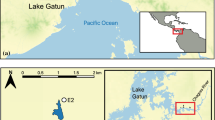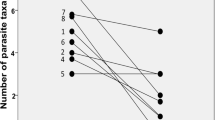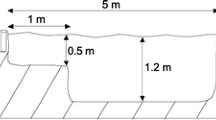Abstract
Populations of invasive species tend to have fewer parasites in their introduced ranges than in their native ranges and are also thought to have fewer parasites than native prey. This ‘release’ from parasites has unstudied implications for native predators feeding on exotic prey. In particular, shifts from native to exotic prey should reduce levels of trophically transmitted parasites. We tested this hypothesis in native populations of pumpkinseed sunfish (Lepomis gibbosus) in Lake Opinicon, where fish stomach contents were studied intensively in the 1970s, prior to the appearance of exotic zebra mussels (Dreissena polymorpha) in the mid-1990s. Zebra mussels were common in stomachs of present-day pumpkinseeds, and stable isotopes of carbon and nitrogen confirmed their importance in long-term diets. Because historical parasite data were not available in Lake Opinicon, we also surveyed stomach contents and parasites in pumpkinseed in both Lake Opinicon and an ecologically similar, neighboring lake where zebra mussels were absent. Stomach contents of pumpkinseed in the companion lake did not differ from those of pre-invasion fish from Lake Opinicon. The companion lake, therefore, served as a surrogate “pre-invasion” reference to assess effects of zebra mussel consumption on parasites in pumpkinseed. Trophically transmitted parasites were less species-rich and abundant in Lake Opinicon, where fish fed on zebra mussels, although factors other than zebra mussel consumption may contribute to these differences. Predation on zebra mussels has clearly contributed to a novel trophic coupling between littoral and pelagic food webs in Lake Opinicon.





Similar content being viewed by others
References
Ackerman JD, Sim B, Nichols SJ, Claudi R (1994) A review of the early life history of zebra mussels (Dreissena polymorpha): comparisons with marine bivalves. Can J Zool 72:1169–1179
Amundsen PA, Lafferty KD, Knudsen R, Primicerio R, Kristoffersen R, Klemetsen A, Kuris AM (2013) New parasites and predators follow the introduction of two fish species to a subarctic lake: implications for food-web structure and functioning. Oecologia. 171:993–1002
Andraso GM (2005) Summer food habits of pumpkinseeds (Lepomis gibbosus) and bluegills (Lepomis macrochirus) in Presque Isle Bay, Lake Erie. J Great Lakes Res 31:397–404
Bertrand M, Marcogliese DJ, Magnan P (2008) Trophic polymorphism in brook charr revealed by diet, parasites and morphometrics. J Fish Biol 72:555–572
Bulté G, Blouin-Demers G (2008) Northern map turtles (Graptemys geographica) derive energy from the pelagic pathway through predation on zebra mussels (Dreissena polymorpha). Freshw Biol 53:497–508
Bulté G, Robinson SA, Forbes MR, Marcogliese DJ (2012) Is there such thing as a parasite free lunch? The direct and indirect consequences of eating invasive prey. Ecohealth 9:6–16
Carlton JT (2008) The zebra mussel Dreissena polymorpha found in North America in 1986 and 1987. J Great Lakes Res 34:770–773
Catford JA, Jansson R, Nilsson C (2009) Reducing redundancy in invasion ecology by integrating hypotheses into a single theoretical framework. Divers Distrib 15:22–40
Caut S, Angulo E, Courchamp F (2009) Variation in discrimination factors (Δ15N and Δ13C): the effect of diet isotopic values and applications for diet reconstruction. J Appl Ecol 46:443–453
Colautti RI, Ricciardi A, Grigorovich IA, MacIsaac HJ (2004) Is invasion success explained by the enemy release hypothesis? Ecol Lett 7:721–733
Conn DB, Conn DA (1993) Parasitism, predation and other biotic associations between dreissenid mussels and native animals in the St. Lawrence River. In: Tsou JL (ed) Proceedings of the 3rd international zebra mussel conference. Electric Power Research Institute, Palo Alto, CA, pp 223–234
Daszak P, Cunningham AA, Hyatt AD (2000) Emerging infectious diseases of wildlife—threats to biodiversity and human health. Science 287:443–449
Désilets HD, Locke SA, McLaughlin JD, Marcogliese DJ (2013) Community structure of Diplostomum spp. (Digenea: Diplostomidae) in eyes of fish: Main determinants and potential interspecific interactions. Int J Parasitol 43:929–939
Dunn AM (2009) Parasites and biological invasions. Adv Parasitol 68:161–184
Fellis JK, Esch GW (2005) Variation in life cycle affects the distance decay of similarity among bluegill sunfish parasite communities. J Parasitol 91:1484–1486
Hebert PDN, Muncaster BW, Mackie GL (1989) Ecological and genetic studies on Dreissena polymorpha (Pallas): a new mollusc in the Great Lakes. Can J Fish Aquat Sci 46:1587–1591
Higgins SN, Vander Zanden MJ (2010) What a difference a species makes: a meta-analysis of dreissenid mussel impacts on freshwater ecosystems. Ecol Monogr 80:179–196
Johnson MW, Hesslein RH, Dick TA (2004) Host length, age, diet, parasites and stable isotopes as predictors of yellow perch (Perca flavescens Mitchill), trophic status in nutrient poor Canadian Shield lakes. Environ Biol Fishes 71:379–388
Karatayev AY, Mastitsky SE, Burlakova LE, Karatayev VA, Hajduk MM, Conn DB (2012) Exotic molluscs in the Great Lakes host epizootically important trematodes. J Shellfish Res 31:885–894
Keast A (1978) Feeding interrelations between age-groups of pumpkinseed (Lepomis gibbosus) and comparisons with bluegill (L. macrochirus). J Fish Res Board Can 35:12–27
Kelly DW, Paterson RA, Townsend CR, Poulin R, Tompkins DM (2009) Parasite spillback: a neglected concept in invasion ecology? Ecology 90:2047–2056
Kim Y, Powell EN (2007) Distribution of parasites and pathologies in sentinel bivalves: NOAA statues and trends “mussels watch” program. J Shellfish Res 26:1115–1151
Locke SA, Levy MS, Marcogliese DJ, Ackerman S, McLaughlin JD (2012) The decay of parasite community similarity in ring-billed gulls Larus delawarensis and other hosts. Ecography 35:530–538
Locke SA, Bulté G, Forbes MR, Marcogliese DJ (2013a) Estimating diet in individual Lepomis gibbosus using stomach contents, stable isotopes and parasites. J Fish Biol 82:522–537
Locke SA, McLaughlin JD, Marcogliese DJ (2013b) Predicting the similarity of parasite communities in freshwater fishes using the phylogeny, ecology and proximity of hosts. Oikos 122:73–83
Locke SA, Marcogliese DJ, Valtonen ET (2014). Vulnerability and diet breadth predict larval and adult parasite diversity in fish of the Bothnian Bay. Oecologia. 174:253–262
Mackie GL, Schloesser DW (1996) Comparative biology of zebra mussels in Europe and North America: an overview. Am Zool 36:244–258
Mastitsky SE, Veres JK (2010) Field evidence for a parasite spill-back caused by exotic mollusc Dreissena polymorpha in an invaded lake. Parasitol Res 106:667–675
Mercer JL, Fox MG, Metcalfe CD (1999) Changes in benthos and three littoral zone fishes in a shallow, eutrophic Ontario Lake following the invasion of the zebra mussel (Dreissena polymorpha). Lake Reserv Manag 15:310–323
Molloy DP, Karatayev AY, Burlakova LE, Kurandina DP, Laruelle F (1997) Natural enemies of zebra mussels: predators, parasites, and ecological competitors. Rev Fish Sci 5:27–97
Parnell A, Inger R, Bearhop S, Jackson AL (2010) Source partitioning using stable isotopes: coping with too much variation. PLoS ONE 3:e9672
Post DM (2002) Using stable isotopes to estimate trophic position: models, methods, and assumptions. Ecology 83:703–718
Prenter J, MacNeil C, Dick JTA, Dunn A (2004) Roles of parasites in animal invasions. Trends Ecol Evol 19:385–390
R Development Core Team (2008) R: a language and environment for statistical computing. R Foundation for Statistical Computing, Vienna, Austria. ISBN:3-900051-07-0. http://www.R-project.org
Schindler DE, Scheuerell MD (2002) Habitat coupling in lake ecosystems. Oikos 98:177–189
Serrouya R, Ricciardi A, Whoriskey FG (1995) Predation on zebra mussels (Dreissena polymorpha) by captive-reared map turtles (Graptemys geographica). Can J Zool 73:2238–2243
Steinauer ML, Nickol BB, Ortí G (2007) Cryptic speciation and patterns of phenotypic variation of a highly variable acanthocephalan parasite. Mol Ecol 16:4097–4109
Strayer DL (2009) Twenty years of zebra mussels: lessons from the mollusk that made the headlines. Front Ecol Environ 7:135–141
Toews SM, Beverley-Burton M, Lawrimore T (1993) Helminth and protist parasites of zebra mussels, Dreissena polymorpha (Pallas, 1771), in the Great Lakes region of southwestern Ontario, with comments on associated bacteria. Can J Zool 71:1763–1766
Torchin ME, Lafferty KD, Dobson AP, McKenzie VJ, Kuris AM (2003) Introduced species and their missing parasites. Nature 421:628–630
Valtonen ET, Marcogliese DJ, Julkunen M (2010) Vertebrate diets derived from trophically transmitted fish parasites in the Bothnian Bay. Oecologia 162:139–152
Vander Zanden MJ, Vadeboncoeur Y (2002) Fishes as integrators of benthic and pelagic food webs in lakes. Ecology 83:2152–2161
Ward JM, Ricciardi A (2007) Impacts of Dreissena invasions on benthic macroinvertebrate communities: a meta-analysis. Divers Distrib 13:155–165
Acknowledgments
This study was funded by a Visiting Fellowship in a Canadian Government Laboratory from the Natural Sciences and Engineering Research Council of Canada (S.A.L.), and post-doctoral fellowships from the Ontario Ministry of Research and Innovation and the Fond Québecois de Recherche sur La Nature et les Technologies (G.B.). We wish to thank V. Putinsky, A. Rose, W. Shim, S. Trépanier and Queen’s University Biological Station for assistance in the laboratory and in the field and logistical support. Handling editor Steve Kohler and two anonymous reviewers provided helpful critical comments.
Author information
Authors and Affiliations
Corresponding author
Additional information
Communicated by Steven Kohler.
S. A. Locke and G. Bulté contributed equally.
Rights and permissions
About this article
Cite this article
Locke, S.A., Bulté, G., Marcogliese, D.J. et al. Altered trophic pathway and parasitism in a native predator (Lepomis gibbosus) feeding on introduced prey (Dreissena polymorpha). Oecologia 175, 315–324 (2014). https://doi.org/10.1007/s00442-014-2898-6
Received:
Accepted:
Published:
Issue Date:
DOI: https://doi.org/10.1007/s00442-014-2898-6




